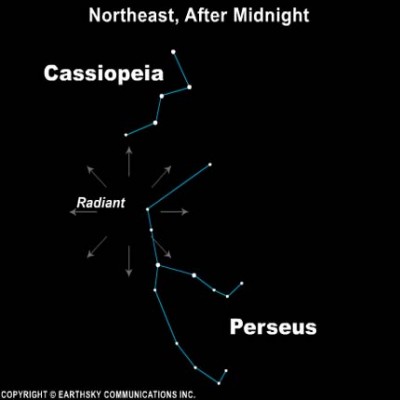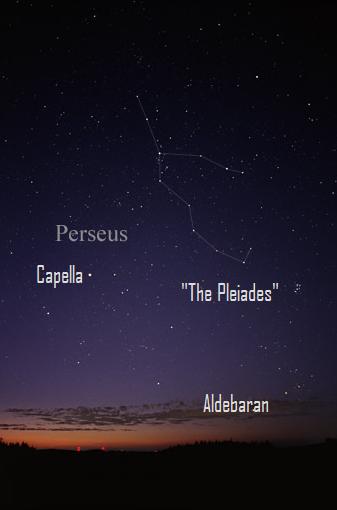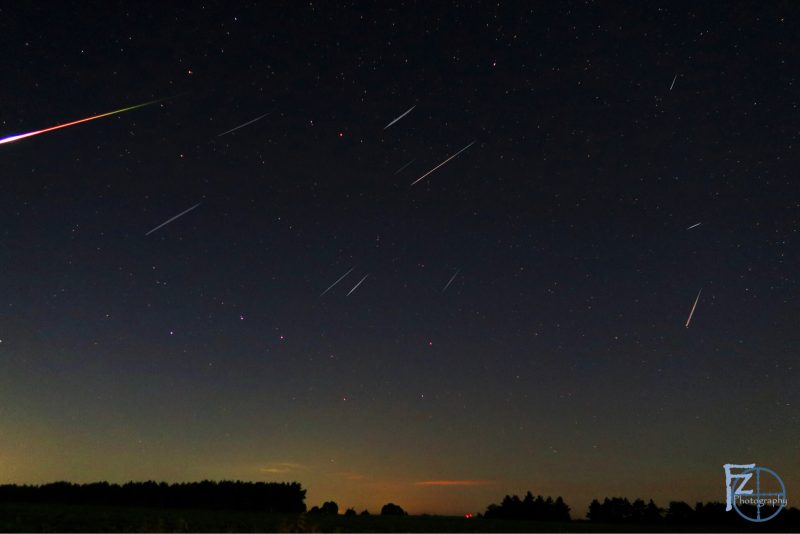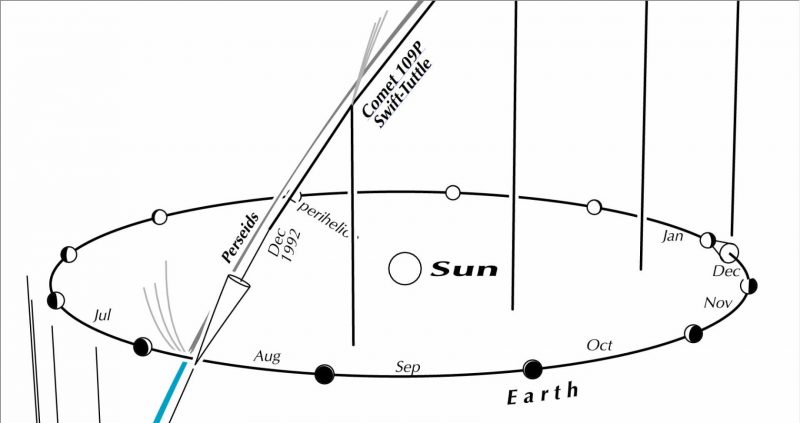

View at EarthSky Community Photos. | James Younger caught this colorful meteor on July 26, 2020, over the Salish Sea, from the shores of British Columbia in Canada. Was it a Perseid? The shower was rising to a peak then. The Perseids are known for being colorful. And this meteor is coming from the right direction. So possibly! Thank you, James!
The annual Perseid meteor shower is one of the most beloved meteor showers of the year, especially in the Northern Hemisphere, where the shower peaks on warm summer nights. No matter where you live worldwide, the 2020 Perseid meteor shower will probably produce the greatest number of meteors on the mornings of August 11, 12 and 13. On the peak mornings in 2020, the moon will be at or slightly past its last quarter phase, so moonlight will somewhat mar this year’s production. Still, there are some ways you can minimize the moon and optimize your chances for a good display of Perseids this year. Here are some thoughts:
1. The Perseids tend to be bright, and a good percentage of them should be able to overcome the moonlight. Who knows? You still might see up to 40 to 50 meteors per hour at the shower’s peak, even in the light of a bright moon. Will you see over 100 per hour, as in some years? Not likely. Still …
2. Try to watch after midnight but before moonrise. In a typical year, meteor numbers increase after midnight. But – before dawn on all three peak mornings (August 11, 12 and 13) – fairly bright moonlight will flood the sky. Be aware that the Perseid meteors will start to fly in mid-to-late evening from northerly latitudes. South of the equator, the Perseids start to streak the sky around midnight. On each of the three peak mornings, there will be less and less moonlight. Visit the Sunrise Sunset Calendars site to find out when the moon sets in your sky on each of those mornings, remembering to check the moonrise and moonset box. Here’s an added bonus for evening observing. If fortune smiles upon you, the evening hours might offer you an earthgrazer – a looooong, slow, colorful meteor traveling horizontally across the evening sky. Earthgrazer meteors are rare but memorable. Perseid earthgrazers appear before midnight, when the radiant point of the shower is close to the horizon.
3. Watch in moonlight, but place yourself in the moon’s shadow. Just place some large structure or natural object – a barn, a cabin, a mountain – between you and the moon. You’ll see more meteors that way than if you’re standing out under the blazing moonlight itself.
4. Consider watching after the peak. People tend to focus on the peak mornings of meteor showers, and that’s entirely appropriate. But meteors in annual showers – which come from streams of debris left behind in space by comets – typically last weeks, not days. Perseid meteors have been streaking across our skies since around July 17. We’ll see Perseids for 10 days or so after the peak mornings on August 11, 12 and 13, though at considerably reduced numbers. Yet, each day as the moon wanes in the morning sky, less moonlight will obtrude on the show. Starting on or around August 17, moon-free skies reign all night long.
Also remember, the the Delta Aquariid meteor shower is still rambling along steadily. You’ll see mostly Perseids, but also some Delta Aquariids in the mix. There’s an explanation of how to tell the difference toward the bottom of this article.
In the Northern Hemisphere, we rank the August Perseids as an all-time favorite meteor shower of every year. For us, this major shower takes place during the lazy, hazy days of summer, when many families are on vacation. And what could be more luxurious than taking a siesta in the heat of the day and watching this summertime classic in the relative coolness of night?
Looking for a dark area to observe from? Check out EarthSky’s worldwide Best Places to Stargaze map.

The radiant point for the Perseid meteor shower is in the constellation Perseus. But you don’t have to find a shower’s radiant point to see meteors. Instead, the meteors will be flying in all parts of the sky.
What is the radiant point for the Perseid meteor shower? If you trace all the Perseid meteors backward, they all seem to come from the constellation Perseus, near the famous Double Cluster. Hence, the meteor shower is named in the honor of the constellation Perseus the Hero.
However, this is a chance alignment of the meteor shower radiant with the constellation Perseus. The stars in Perseus are light-years distant while these meteors burn up about 60 miles (100 km) above the Earth’s surface. If any meteor survives its fiery plunge to hit the ground intact, the remaining portion is called a meteorite. Few – if any – meteors in meteor showers become meteorites, however, because of the flimsy nature of comet debris. Most meteorites are the remains of asteroids.
In ancient Greek star lore, Perseus is the son of the god Zeus and the mortal Danaë. It is said that the Perseid shower commemorates the time when Zeus visited Danaë, the mother of Perseus, in a shower of gold.

From mid-northern latitudes, the constellation Perseus, the stars Capella and Aldebaran, and the Pleiades cluster light up the northeast sky in the wee hours after midnight on August nights. The meteors radiate from Perseus. Photo: Till Credner, AlltheSky.com

Here’s a cool binocular object to look for while you’re watching the meteors. The constellation Cassiopeia points out the famous Double Cluster in the northern tip of the constellation Perseus. Plus, the Double Cluster nearly marks the radiant of the Perseid meteor shower. Photo by Flickr user madmiked.
General rules for Perseid-watching. No special equipment, or knowledge of the constellations, needed.
Find a dark, open sky to enjoy the show. An open sky is essential because these meteors fly across the sky in many different directions and in front of numerous constellations.
Give yourself at least an hour of observing time, because the meteors in meteor showers come in spurts and are interspersed with lulls. Remember, your eyes can take as long as 20 minutes to adapt to the darkness of night. So don’t rush the process.
Know that the meteors all come from a single point in the sky. If you trace the paths of the Perseid meteors backwards, you’d find they all come from a point in front of the constellation Perseus. Don’t worry about which stars are Perseus. Just enjoying knowing and observing that they all come from one place on the sky’s dome.
Enjoy the comfort of a reclining lawn chair. Bring along some other things you might enjoy also, like a thermos filled with a hot drink.
Remember … all good things come to those who wait. Meteors are part of nature. There’s no way to predict exactly how many you’ll see on any given night. Find a good spot, watch, wait.
You’ll see some.

Composite of 12 images acquired on August 13, 2017, by Felix Zai in Toronto. He wrote: “Perseid meteor shower gave a good show even though the moonlight drowned out most of the fainter ones. A huge fireball was captured in this photo.” Thanks, Felix! By the way, it’s only in a meteor “storm” that you’d see this many meteors at once. Even in a rich shower, you typically see only 1 or 2 meteors at a time.
What’s the source of the Perseid meteor shower? Every year, from around July 17 to August 24, our planet Earth crosses the orbital path of Comet Swift-Tuttle, the parent of the Perseid meteor shower. Debris from this comet litters the comet’s orbit, but we don’t really get into the thick of the comet rubble until after the first week of August. The bits and pieces from Comet Swift-Tuttle slam into the Earth’s upper atmosphere at some 130,000 miles (210,000 km) per hour, lighting up the nighttime with fast-moving Perseid meteors.
If our planet happens to pass through an unusually dense clump of meteoroids – comet rubble – we’ll see an elevated number of meteors. We can always hope!
Comet Swift-Tuttle has a very eccentric – oblong – orbit that takes this comet outside the orbit of Pluto when farthest from the sun, and inside the Earth’s orbit when closest to the sun. It orbits the sun in a period of about 133 years. Every time this comet passes through the inner solar system, the sun warms and softens up the ices in the comet, causing it to release fresh comet material into its orbital stream.
Comet Swift-Tuttle last reached perihelion – closest point to the sun – in December 1992 and will do so next in July 2126.

The Perseids happen every year. Their parent comet – Swift-Tuttle – takes about 130 years to orbit the sun once. It last rounded the sun in the early 1990s and is now far away. But we see the Perseids each year, when Earth intersects the comet’s orbit, and debris left behind by Swift-Tuttle enters our atmosphere. Chart via Guy Ottewell.
Bottom line: The 2020 Perseid meteor shower is expected to produce the most meteors in the predawn hours of August 11, 12 and 13, though under the light of a moon at or just past first quarter phase.
Everything you need to know: Delta Aquariid meteor shower
EarthSky’s 2020 meteor shower guide
from EarthSky https://ift.tt/2OavTIz


View at EarthSky Community Photos. | James Younger caught this colorful meteor on July 26, 2020, over the Salish Sea, from the shores of British Columbia in Canada. Was it a Perseid? The shower was rising to a peak then. The Perseids are known for being colorful. And this meteor is coming from the right direction. So possibly! Thank you, James!
The annual Perseid meteor shower is one of the most beloved meteor showers of the year, especially in the Northern Hemisphere, where the shower peaks on warm summer nights. No matter where you live worldwide, the 2020 Perseid meteor shower will probably produce the greatest number of meteors on the mornings of August 11, 12 and 13. On the peak mornings in 2020, the moon will be at or slightly past its last quarter phase, so moonlight will somewhat mar this year’s production. Still, there are some ways you can minimize the moon and optimize your chances for a good display of Perseids this year. Here are some thoughts:
1. The Perseids tend to be bright, and a good percentage of them should be able to overcome the moonlight. Who knows? You still might see up to 40 to 50 meteors per hour at the shower’s peak, even in the light of a bright moon. Will you see over 100 per hour, as in some years? Not likely. Still …
2. Try to watch after midnight but before moonrise. In a typical year, meteor numbers increase after midnight. But – before dawn on all three peak mornings (August 11, 12 and 13) – fairly bright moonlight will flood the sky. Be aware that the Perseid meteors will start to fly in mid-to-late evening from northerly latitudes. South of the equator, the Perseids start to streak the sky around midnight. On each of the three peak mornings, there will be less and less moonlight. Visit the Sunrise Sunset Calendars site to find out when the moon sets in your sky on each of those mornings, remembering to check the moonrise and moonset box. Here’s an added bonus for evening observing. If fortune smiles upon you, the evening hours might offer you an earthgrazer – a looooong, slow, colorful meteor traveling horizontally across the evening sky. Earthgrazer meteors are rare but memorable. Perseid earthgrazers appear before midnight, when the radiant point of the shower is close to the horizon.
3. Watch in moonlight, but place yourself in the moon’s shadow. Just place some large structure or natural object – a barn, a cabin, a mountain – between you and the moon. You’ll see more meteors that way than if you’re standing out under the blazing moonlight itself.
4. Consider watching after the peak. People tend to focus on the peak mornings of meteor showers, and that’s entirely appropriate. But meteors in annual showers – which come from streams of debris left behind in space by comets – typically last weeks, not days. Perseid meteors have been streaking across our skies since around July 17. We’ll see Perseids for 10 days or so after the peak mornings on August 11, 12 and 13, though at considerably reduced numbers. Yet, each day as the moon wanes in the morning sky, less moonlight will obtrude on the show. Starting on or around August 17, moon-free skies reign all night long.
Also remember, the the Delta Aquariid meteor shower is still rambling along steadily. You’ll see mostly Perseids, but also some Delta Aquariids in the mix. There’s an explanation of how to tell the difference toward the bottom of this article.
In the Northern Hemisphere, we rank the August Perseids as an all-time favorite meteor shower of every year. For us, this major shower takes place during the lazy, hazy days of summer, when many families are on vacation. And what could be more luxurious than taking a siesta in the heat of the day and watching this summertime classic in the relative coolness of night?
Looking for a dark area to observe from? Check out EarthSky’s worldwide Best Places to Stargaze map.

The radiant point for the Perseid meteor shower is in the constellation Perseus. But you don’t have to find a shower’s radiant point to see meteors. Instead, the meteors will be flying in all parts of the sky.
What is the radiant point for the Perseid meteor shower? If you trace all the Perseid meteors backward, they all seem to come from the constellation Perseus, near the famous Double Cluster. Hence, the meteor shower is named in the honor of the constellation Perseus the Hero.
However, this is a chance alignment of the meteor shower radiant with the constellation Perseus. The stars in Perseus are light-years distant while these meteors burn up about 60 miles (100 km) above the Earth’s surface. If any meteor survives its fiery plunge to hit the ground intact, the remaining portion is called a meteorite. Few – if any – meteors in meteor showers become meteorites, however, because of the flimsy nature of comet debris. Most meteorites are the remains of asteroids.
In ancient Greek star lore, Perseus is the son of the god Zeus and the mortal Danaë. It is said that the Perseid shower commemorates the time when Zeus visited Danaë, the mother of Perseus, in a shower of gold.

From mid-northern latitudes, the constellation Perseus, the stars Capella and Aldebaran, and the Pleiades cluster light up the northeast sky in the wee hours after midnight on August nights. The meteors radiate from Perseus. Photo: Till Credner, AlltheSky.com

Here’s a cool binocular object to look for while you’re watching the meteors. The constellation Cassiopeia points out the famous Double Cluster in the northern tip of the constellation Perseus. Plus, the Double Cluster nearly marks the radiant of the Perseid meteor shower. Photo by Flickr user madmiked.
General rules for Perseid-watching. No special equipment, or knowledge of the constellations, needed.
Find a dark, open sky to enjoy the show. An open sky is essential because these meteors fly across the sky in many different directions and in front of numerous constellations.
Give yourself at least an hour of observing time, because the meteors in meteor showers come in spurts and are interspersed with lulls. Remember, your eyes can take as long as 20 minutes to adapt to the darkness of night. So don’t rush the process.
Know that the meteors all come from a single point in the sky. If you trace the paths of the Perseid meteors backwards, you’d find they all come from a point in front of the constellation Perseus. Don’t worry about which stars are Perseus. Just enjoying knowing and observing that they all come from one place on the sky’s dome.
Enjoy the comfort of a reclining lawn chair. Bring along some other things you might enjoy also, like a thermos filled with a hot drink.
Remember … all good things come to those who wait. Meteors are part of nature. There’s no way to predict exactly how many you’ll see on any given night. Find a good spot, watch, wait.
You’ll see some.

Composite of 12 images acquired on August 13, 2017, by Felix Zai in Toronto. He wrote: “Perseid meteor shower gave a good show even though the moonlight drowned out most of the fainter ones. A huge fireball was captured in this photo.” Thanks, Felix! By the way, it’s only in a meteor “storm” that you’d see this many meteors at once. Even in a rich shower, you typically see only 1 or 2 meteors at a time.
What’s the source of the Perseid meteor shower? Every year, from around July 17 to August 24, our planet Earth crosses the orbital path of Comet Swift-Tuttle, the parent of the Perseid meteor shower. Debris from this comet litters the comet’s orbit, but we don’t really get into the thick of the comet rubble until after the first week of August. The bits and pieces from Comet Swift-Tuttle slam into the Earth’s upper atmosphere at some 130,000 miles (210,000 km) per hour, lighting up the nighttime with fast-moving Perseid meteors.
If our planet happens to pass through an unusually dense clump of meteoroids – comet rubble – we’ll see an elevated number of meteors. We can always hope!
Comet Swift-Tuttle has a very eccentric – oblong – orbit that takes this comet outside the orbit of Pluto when farthest from the sun, and inside the Earth’s orbit when closest to the sun. It orbits the sun in a period of about 133 years. Every time this comet passes through the inner solar system, the sun warms and softens up the ices in the comet, causing it to release fresh comet material into its orbital stream.
Comet Swift-Tuttle last reached perihelion – closest point to the sun – in December 1992 and will do so next in July 2126.

The Perseids happen every year. Their parent comet – Swift-Tuttle – takes about 130 years to orbit the sun once. It last rounded the sun in the early 1990s and is now far away. But we see the Perseids each year, when Earth intersects the comet’s orbit, and debris left behind by Swift-Tuttle enters our atmosphere. Chart via Guy Ottewell.
Bottom line: The 2020 Perseid meteor shower is expected to produce the most meteors in the predawn hours of August 11, 12 and 13, though under the light of a moon at or just past first quarter phase.
Everything you need to know: Delta Aquariid meteor shower
EarthSky’s 2020 meteor shower guide
from EarthSky https://ift.tt/2OavTIz

Aucun commentaire:
Enregistrer un commentaire